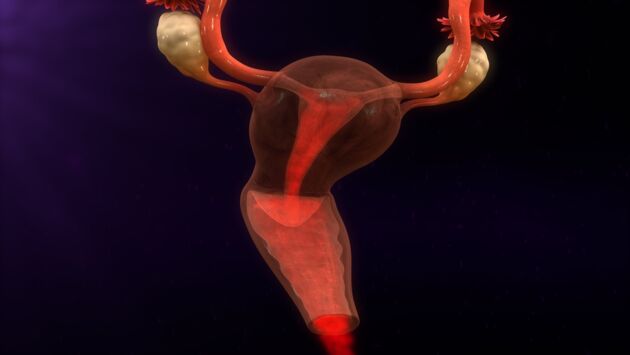Had a C Section Bleeding Stopped Then Started Again
Bleeding after vaginal commitment
Later on delivery, it is normal to take bleeding and vaginal discharge. This is called lochia.
During the start three to four days afterward delivery, lochia will be more abundant than menstrual discharge, and then the amount will decrease.
In addition, the colour will gradually change. For three to 4 days after giving nascency, it will be bright cerise. At this time, in that location might exist brown clots, likewise.
Betwixt the fifth and tenth 24-hour interval, lochia should modify to pink-dark-brown or chocolate-brown.
Later on this, the discharge volition and so become white or xanthous, be gratuitous of blood clots, and accept a sharp smell. Discharge is an important indicator of health, so make sure to keep track of it.
If yous notice any abnormalities, consult a health intendance provider.
Have a quiz
Find out what you can exercise with our Health Banana
What causes bleeding after childbirth?
Profuse postpartum bleeding after vaginal delivery can be due to:
- Uterine atony. The most common cause of postpartum hemorrhage is uterine atony. This is a condition when the uterus fails to contract after childbirth. This puts the mother at take a chance of postpartum hemorrhage (PPH). In fact, uterine atony is the leading cause of postpartum bleeding.
- Laceration. Postpartum bleeding can also happen because of uterine, cervical, or vaginal lacerations. The health intendance provider may need to do a proper test to rule out laceration as the cause of PPH. A uterine rupture may also cause postpartum bleeding. This is something the health care provider should be enlightened of and should check to find out the cause. There are several take a chance factors for uterine rupture, including vaginal birth after cesarean department, uterine scars, and trauma.
- Retained or trapped placenta. A retained or trapped placenta is when the placenta is not expelled from the uterus. This normally happens when the placenta partially detaches from the lining of the uterus, causing the uterus to contract improperly. The blood vessels within the uterus continue to drain as long every bit there is a retained placenta in the uterus.
- Placenta accreta. This is a condition when the placenta attaches likewise deeply into the uterine wall. There are two other like conditions: placenta increta and placenta percreta. These 3 weather are differentiated by the abnormality (i.e., depth) of their attachment to the uterine wall. When placenta accreta occurs, information technology tin cause PPH, especially when the OB-GYN attempts to remove the placenta.
- Uterine inversion. This is a complication that can occur later childbirth when the uterus turns inside out. When this happens, symptoms such as postpartum haemorrhage, low claret pressure, and abdominal pain may occur. A uterine inversion may occur if the uterus is weak or the umbilical string is short.

Bleeding after cesarean delivery
Common causes of bleeding after cesarean delivery include:
- Uterine trauma
- Placenta accreta
- Uterine atony
- Lacerations
Postpartum bleeding: how much claret is normal?
After childbirth, some bleeding and spotting is completely normal. And this may last for about four to six weeks.
Heavy haemorrhage after giving birth is chosen postpartum hemorrhage.
According to medical experts, blood loss or postpartum haemorrhage is excessive when information technology'south more than 500 milliliters of blood subsequently vaginal birth and more i,000 milliliters after a C-section. This tin crusade a lot of complications that can put overall health at take chances.
It's nearly probable to happen within the first 24 hours after delivery. But it tin happen anytime within the offset several weeks after giving birth.
Signs of abnormal postnatal bleeding
How do you know that you have abnormal haemorrhage? Many people don't know that they have a heavy postpartum hemorrhage until they start to experience certain symptoms such as weakness, nausea, rapid heart rate, and dizziness. There are other symptoms that tin can indicate abnormal haemorrhage before these other symptoms ascend:
- Bleeding that soaks more one pad an hour
- Blood clots that seem abnormally large (bigger than a plum)
- A continuous menses that does not seem to stop
Other signs that may accompany abnormal postnatal haemorrhage include:
- Depression claret force per unit area (hypotension)
- Dizziness
- Weakness
- Nausea
- Increased middle rate
- Faintness
- Blurred vision
- Chills
- Restlessness
- Rapid animate
- Pain and swelling in the vagina and nearby area if haemorrhage is from a hematoma
Bleeding excessively and continuously is a major sign of aberrant postnatal bleeding. Other symptoms like increased heart rate, rapid animate, and nausea on elevation of the heavy bleeding are sure signs that something is wrong. If you're experiencing symptoms like this, make sure to become medical attention every bit before long as possible.
What is the treatment for postpartum haemorrhage?
There are several ways to care for postpartum hemorrhage. The pick of treatment, however, depends on the cause and severity of the postpartum haemorrhage.
Some treatment options for postpartum bleeding include:
Medication — Uterotonic medication is usually the commencement choice of treatment for postpartum hemorrhage. Information technology helps the uterus to contract, stopping the bleeding.
Uterine massage — When a health care provider notices heavy bleeding subsequently delivery, they may attempt to stop information technology by massaging the uterus. This helps the uterus to contract, which consequently stops the bleeding.
Airship tamponade — A uterine balloon tamponade is also quite effective at stopping postpartum bleeding. A device known as a Bakri airship is inflated within the uterus to add pressure and stop the bleeding.
Surgery — A laparotomy is a surgical operation that involves opening up the abdomen to determine the crusade of bleeding. It is considered when less invasive interventions accept failed. The surgeon performs various forms of compression sutures, ligation of the uterine, ovarian or internal iliac artery, and, equally a final resort, a hysterectomy. A hysterectomy is a surgical operation to remove the uterus.
Blood transfusion — This method involves intravenously calculation new claret to the body to replace lost blood.
Uterine artery embolization — With this method, a radiologist conducts special tests to determine which blood vessel is bleeding. The radiologist and so injects small particles into the vessel to terminate the haemorrhage.
Uterine curettage — This method involves removing remaining pieces of the placenta from the uterus either manually or using special tools.
Consult a health care provider to decide on the all-time treatment choice for yous. Abnormal postpartum bleeding may exist a potentially life-threatening condition. Inform your health care provider immediately if you have these symptoms.
Getting dorsum to normal

During postpartum recovery, information technology is important to avert any kind of strenuous activity or exercise, particularly after a postpartum hemorrhage. Information technology is recommended to get lots of rest.
Also, watch what you are eating and drinking. Eat foods that are rich in iron, such as:
- Dark green leafy veggies such equally spinach
- Pumpkin seeds, nuts, and chickpeas
- Lentils
- Beans and peas
- Red meat and seafood
When the body loses blood, it tries to furnish it. With continuous haemorrhage, the body may quickly not take plenty iron to effectively form hemoglobin. This is known as iron deficiency anemia. This is why information technology is important to swallow a nutrition rich in atomic number 26.
It is equally important to add foods rich in vitamin C to your diet as it helps the body to blot atomic number 26. Foods rich in calcium may have a short-term negative effect on iron absorption, and so it's better to limit their intake.
Too, add together loftier-cobweb foods to your diet like whole grains and fruits to avoid constipation.
Lastly, take care of your mental health and well-being. Many people who have had postpartum bleeding often experience postpartum depression. If yous experience postpartum depression, talk to your health care provider or a mental health professional, or join a support grouping of people who have had a similar experience. Support can be helpful for recovery, both physically and mentally.
The Flo period tracker is a great way to go along track of periods, either to track fertility or simply to monitor wellness. Information technology does more assistance you proceed track of your monthly wheel. It also provides data virtually preventing period-related symptoms and managing certain health weather condition such as polycystic ovary syndrome and premenstrual dysphoric disorder.
Source: https://flo.health/being-a-mom/recovering-from-birth/postpartum-problems/abnormal-postpartum-bleeding